Parts of a Book Explained: Front Matter, Body, and Back Matter
Even if you've already polished your chapters to perfection, you still need to prepare various other parts of your book before publishing — namely, the front matter and back matter.
If you haven’t come across these terms before, don’t be intimidated! They simply refer to the first and last sections of a book: the bits that make it look put-together and “official,” rather than like randomly bound pages.
In this guide, we’ll dissect the anatomy of a book, covering which components a publisher can (and should) include in their final product.
In subsequent sections, we'll burrow deeper into the most common and important sections of a book's front, body, and back matter. But first, let's start with a wide-angle view, beginning with...
The front matter
The front matter of a book consists of its very first pages: the title page, copyright page, table of contents, etc. There may also be a preface by the author, or a foreword by someone familiar with their work.
Though many readers skip right over it, the front matter contains some pretty important information about the book's author and publisher. And for those who DO read it, the front matter forms their first impression, so make sure you get it right!
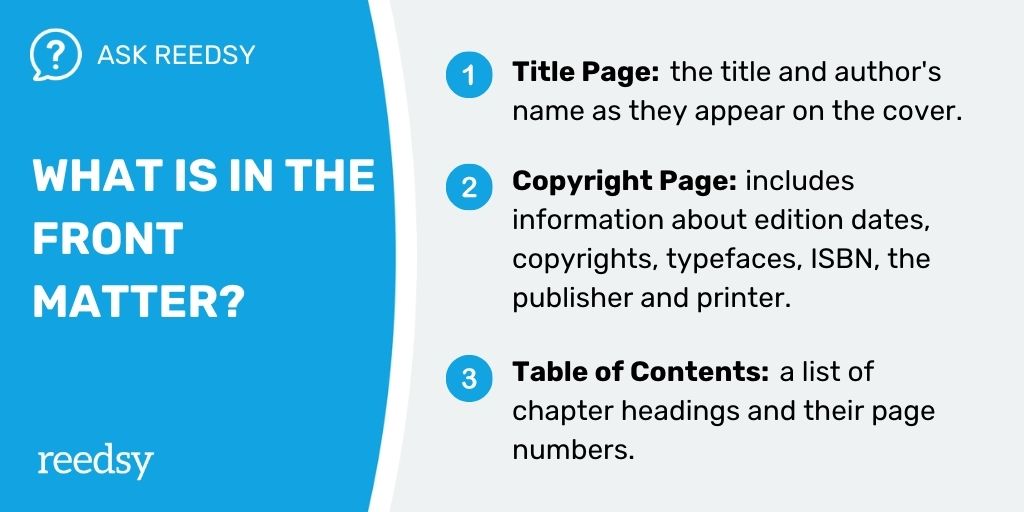 Title page
Title page
The full title and author's name — as they appear on the cover.
Frontispiece
A decorative illustration or photo on the page next to the title page. Typically goes on the left.

Accolades
Quotes from esteemed reviewers and publications in praise of the book. This praise often appears on the back cover as well.
Copyright page
Also called a “colophon,” the copyright page includes technical information about copyrights, edition dates, typefaces, ISBN, as well as your publisher and printer. Usually appears on the reverse of the title page.
Dedication page
A page where the author names the person or people to whom they dedicate their book, and why. This typically comes after the copyright page.
Table of contents
A list of chapter headings and the page numbers where they begin. The table of contents (abbreviated ToC) should list all major sections that follow it, both body and back matter.
Epigraph
A quote or excerpt that indicates the book's subject matter, the epigraph can be taken from another book, a poem, a song, or almost any source. It usually comes immediately before the first chapter.
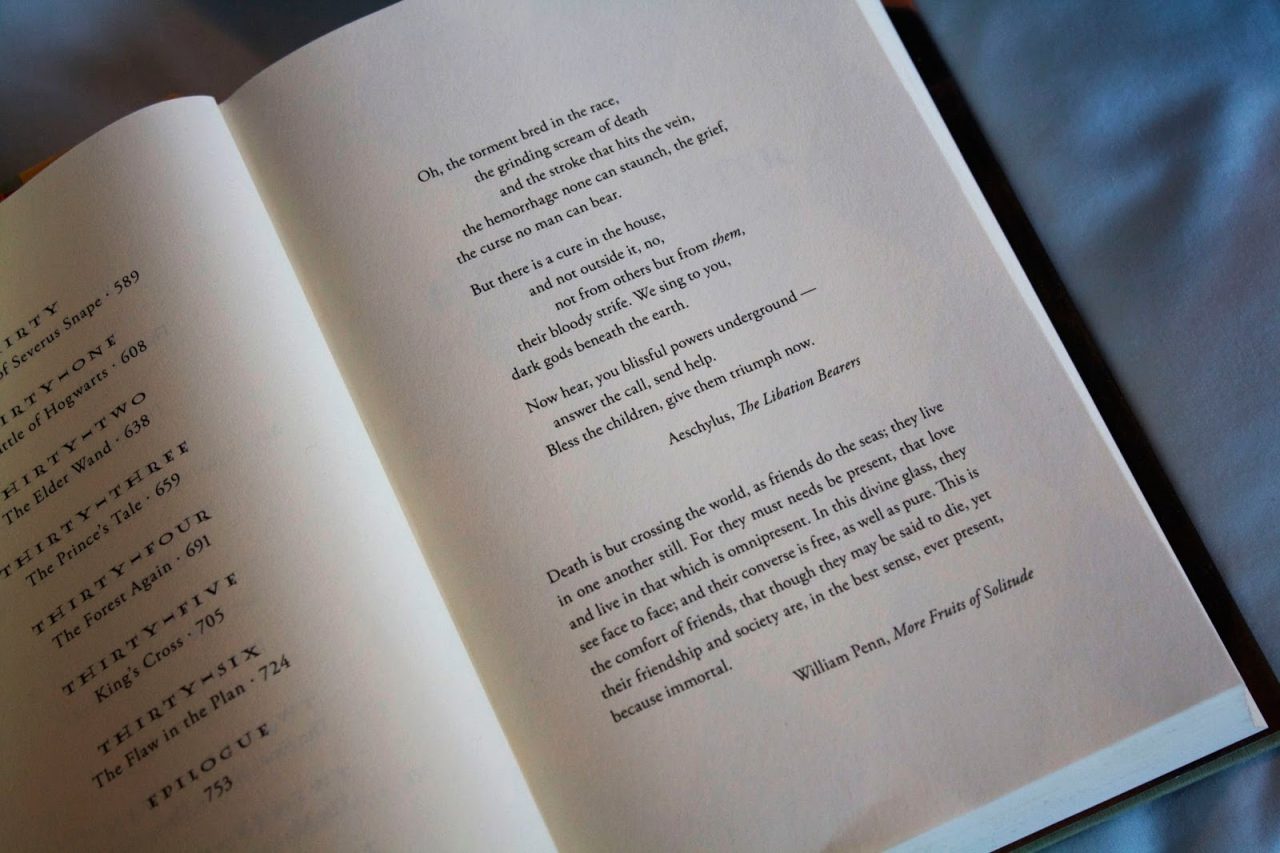
Preface
An introduction written by the author, a preface relates how the book came into being, or provides context for the current edition.
Foreword
An introduction written by another person, usually a friend, family member, or scholar of the author's work.
The body
The body of a book is pretty self-explanatory: the main text that goes between the front matter and back matter. For readers and writers alike, this is where the magic happens — but it's not just the content that's crucial, but also how you arrange it. Don't worry, we'll show you how!
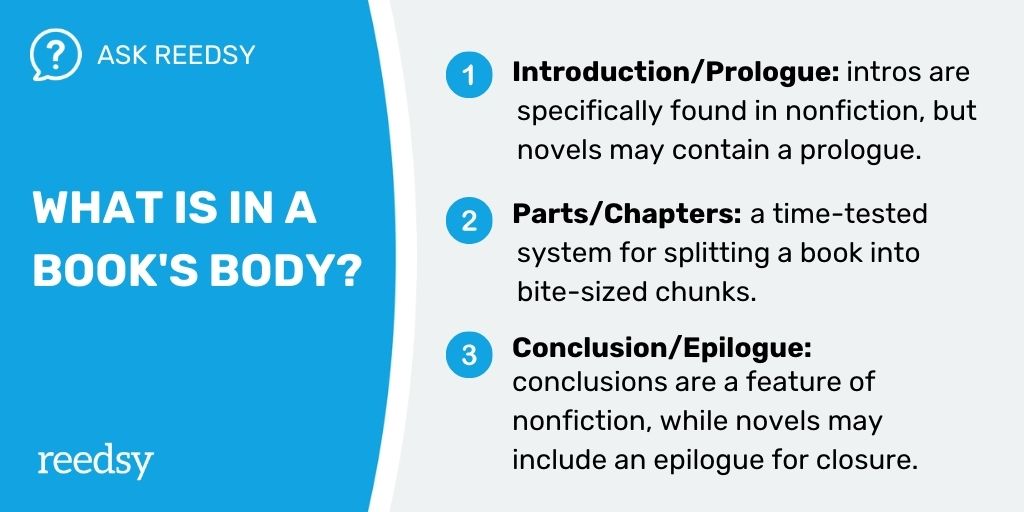
Prologue (for fiction)
A section just before the main story begins, a prologue aims to set the stage and intrigue the reader. Indeed, many prologues contain intriguing events that only become contextualized later in the story.
Introduction (for nonfiction)
A few pages that usher the reader into the subject matter. The intro goes over early events or information related to the main narrative, so the reader has a solid footing before they begin.
“What's the difference between a preface and an introduction? A preface is personal to the author, discussing why they wrote the book and what their process was. An introduction relates directly to the subject matter and really kicks things off — which is why it's part of the body, not the front matter.”
Chapters
Every single book has chapters, or at least sections, into which the narrative is divided. These chapters may not be designated by a chapter heading, or appear in a ToC; some authors start new chapters just by using page breaks. But if you don't use anything to break up your content, your readers will not be happy. (Also, if you're unsure how long your chapters should be, check out this post on the subject!)
Epilogue (for fiction)
A scene that wraps up the story in a satisfying manner, an epilogue often takes place some time in the future. Alternatively, if there are more books to come in the series, the epilogue may raise new questions or hint at what will happen in the next book.

Conclusion (for nonfiction)
A section that sums up the core ideas and concepts of the text. Explicitly labeled conclusions are becoming less common in nonfiction books, which commonly offer final thoughts in the last chapter, but academic theses may still be formatted this way.
Afterword
Any other final notes on the book; can be written by the author or by someone they know.
Postscript
A brief final comment after the narrative comes to an end, usually just a sentence or two (e.g. “Matthew died at sea in 1807, but his memory lives on”).
The back matter
The back matter (also known as the “end matter”) is — you guessed it — material found at the back of a book. Authors use their back matter to offer readers further context or information about the story, though back matter can also be extremely simple: sometimes just a quick mention of the author's website or a note from the publisher.
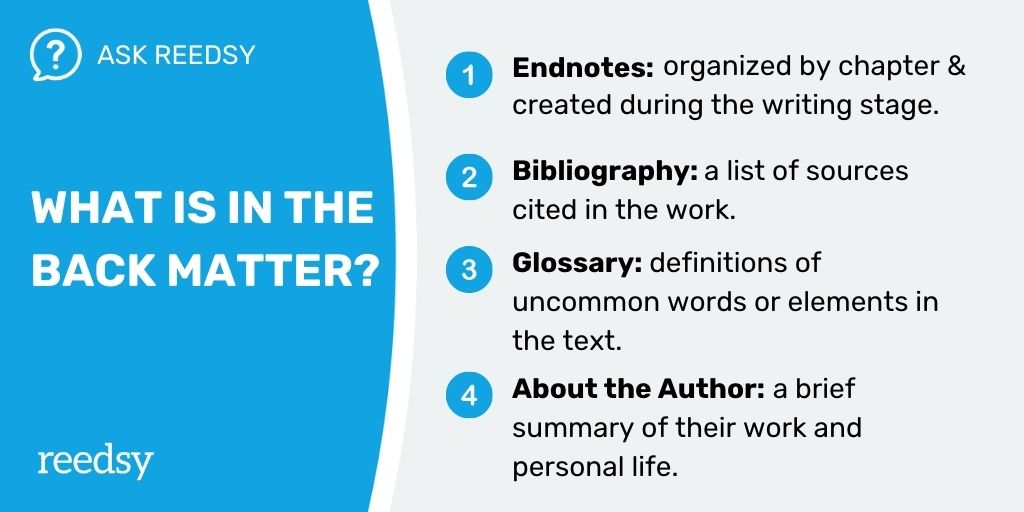
Acknowledgments
A section to acknowledge and thank all those who contributed to the book's creation. This may be the author's agent and editor(s), their close friends and family, and other sources of inspiration. The acknowledgments typically appear right after the last chapter.
About the author
This is where the author gives a brief summary of their previous work, education, and personal life (e.g. “She lives in New York with her husband and two Great Danes”). For more on this topic, read through our guide to writing an author bio or check out some stellar About the Author examples.
Copyright permissions
If the author has sought permission to reproduce song lyrics, artwork, or extended excerpts from other books, they should be attributed here (may also appear in the front matter).
Discussion questions
Thought-provoking questions and prompts about the book, intended for use in an academic context or for book clubs.
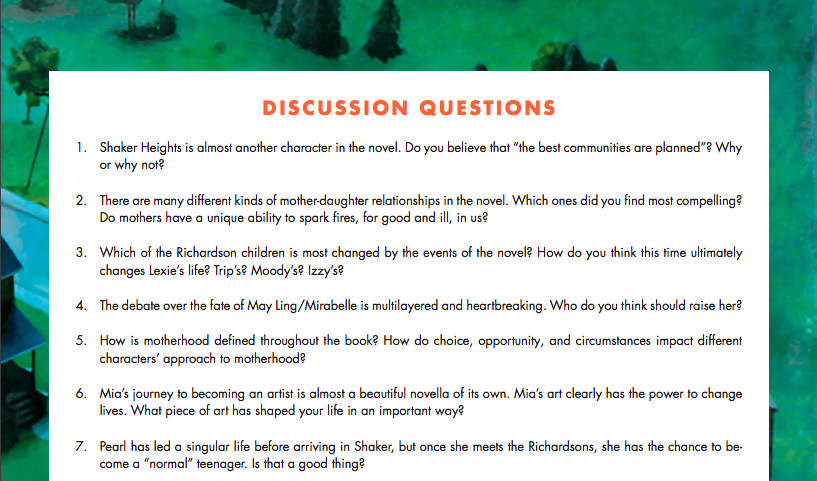
Appendix or addendum (nonfiction)
Additional details or updated information relevant to the book, especially if it's a newer edition.
Chronology or timeline (nonfiction)
List of events in sequential order, which may be helpful for the reader, especially if the narrative is presented out of order. A chronology is sometimes part of the appendix.
Endnotes
Supplementary notes that relate to specific passages of the text, and denoted within the body by superscripts. Almost always used in nonfiction, but occasionally found in experimental/comedic fiction as well, such as Infinite Jest.
Glossary
Definitions of words or other elements that appear in the text. In works of fiction, the glossary may contain entries about individual characters or settings. The glossary usually appears in alphabetical order.
Index
A list of specialty terms or phrases used in the book, along with the pages on which they appear, so the reader can find them easily. The index is also usually in alphabetical order.
Bibliography/reference list
A comprehensive breakdown of sources cited in the work. Your bibliography should follow a manual of style — luckily, it's easy to create one using free tools like Easybib. Note that this is a formal list of citations, not a bonus reading list on your subject; that would go in the afterword or appendix.
Get a professional to format your book
Reedsy's professional designers can make your books look like they belong on the bestsellers lists. Sign up for FREE and meet them today.
Learn how Reedsy can help you craft a beautiful book.
If you're ready to go a little deeper, head to the next part of this guide and prepare to get up close and personal with copyright pages!
Comments are currently closed.

11 responses
Colin Smith says:
04/09/2016 – 14:31
Hello. My work is a 'found text', posing as a fictional revised edition of an equally fictional 19C novel, and also a novel within a novel. This means the front matter is unusually complex with numerous introductory pieces, (fictional) author and editor biographies, two title pages (one for the 'original publication' and one for the 'new edition') and etcetera. I also don't want a table of contents, at least not one listing every chapter. Most novels I own don't have one and I don't see the necessity. So, why is the order of front matter important and how much freedom do I have to override the 'Book Editor' and create my own sections and headings?
↪️ Reedsy replied:
05/09/2016 – 17:32
Hello Colin, Good remarks. The table of contents is definitely optional, as most novels don't have one. Regarding your complex front matter, the Reedsy Book Editor doesn't allow this much customization at this point. We are working on a more sophisticated system though and if you've signed up to Reedsy, you will get a product newsletter about it when it becomes available (in a few months).
↪️ Colin Smith replied:
05/09/2016 – 19:21
Thanks for your reply. Look forward to the release of the new version. I've not signed up with anyone for the moment. Does signing with Reedsy require any commitment on publishing with Reedsy or does it just give access to the newsletter? My work is finished second draft but still in the edit stage.
Kate Gesch says:
14/09/2016 – 02:28
I'm looking at my book settings right now, and I don't see a field for "Dedication." I'd also like to place a disclaimer that "this is a work of fiction, etc." When I downloaded my first draft, there was a blank ABOUT THE AUTHOR page in the end notes. What generates that? My short story only has one chapter- is there a way to remove the "1" from the beginning of the body? Thank you.
Cheesy Factory says:
19/05/2018 – 07:16
This is Great ideas and opinion on frond and back matter book,Thank you so much for this helpful information!
Saloni More says:
18/06/2018 – 13:11
Does Reedsy have a tool used to create a glossary?
Lynn says:
11/08/2018 – 16:00
I have a few questions. Many of us publish eBooks, which are different from print books. 1) I add my book description to the front matter since you can't just turn it over and read it on the back cover like with a print book. As a reader of eBooks (with a long TBR library), I appreciate being able to find it without having to go back online. I place it on the page after the copyright. Is there a better place for it? 2) Is it incorrect to place the acknowledgment page in the back matter? Amazon's sample is approximately 10% (I think) of the book, and if there is too much in the front, there is less body/content for a reader to judge their purchase on. 3) In a series, I typically add a "Previously in the ____ Series" along with the final chapters. This was actually a request from several readers. It does push back the body of the new book, causing the same issue as in question 2. So, that goes before the prologue. Is adding those chapters acceptable? Does this seem like the proper placement? Perhaps it would be better at the end, with a link to it before the prologue? Hope I didn't bog you down with too many questions- lol. Thanks for the great information. '
Elina Chernyshova says:
30/11/2018 – 21:18
Great post https://cgifurniture.com/
Johnny McCarron says:
13/09/2019 – 00:22
It's good to know that authors typically use back matter to offer readers extra book information. I've been thinking for a while about self-publishing my own book. I know POD is an option, but I'm hoping to find a printer from whom to order multiple copies so I can try selling it in print at conventions.
James King says:
17/11/2019 – 09:54
I'd like to know how to create a template of front and back matter, so I only need to enter the chapters of each book.
Joseph Tochuku says:
25/03/2020 – 14:21
The introduction written outside the back cover of most books is called what? and what is the format for writing such.